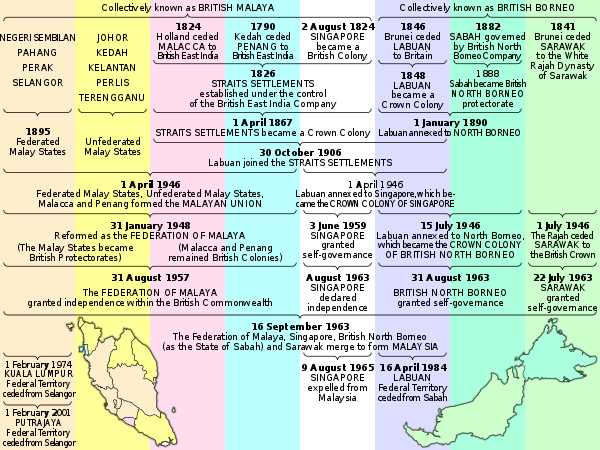Malaysia has a rich history spanning thousands of years. It has seen the rise and fall of various kingdoms and colonial powers.
Malaysia’s history is a fascinating tapestry woven with diverse cultures and significant events. Early Malay kingdoms, such as Langkasuka and Srivijaya, laid the foundation for a thriving maritime trade. The arrival of Islam in the 14th century marked a major cultural shift.
In the 16th century, European colonial powers, including the Portuguese, Dutch, and British, vied for control over the region. British rule significantly influenced Malaysia’s socio-economic landscape. The Japanese occupation during World War II was a tumultuous period. Post-war, Malaysia’s journey towards independence culminated in 1957. Today, Malaysia thrives as a multi-ethnic, multi-religious nation with a vibrant economy.

Credit: www.researchgate.net
Early Inhabitants And Kingdoms
The history of Malaysia is rich and diverse. It dates back thousands of years. Early inhabitants left behind clues of their lives. Ancient kingdoms rose and fell, shaping Malaysia’s culture.
Prehistoric Malaysia: Evidence And Artifacts
Prehistoric Malaysia holds many secrets. Archaeologists found tools, pottery, and cave paintings. These artifacts tell us about early life in Malaysia.
- Tools: Stone tools are some of the oldest artifacts found.
- Pottery: Pottery fragments reveal ancient lifestyles.
- Cave Paintings: Art found in caves shows early human creativity.
These findings are mostly from sites like Niah Cave and Gua Tambun. They date back thousands of years. These artifacts are crucial for understanding Malaysia’s ancient past.
Ancient Kingdoms: Langkasuka And Srivijaya
Malaysia was home to powerful ancient kingdoms. Two of the most notable are Langkasuka and Srivijaya.
| Kingdom | Period | Significance |
|---|---|---|
| Langkasuka | 2nd century | One of the earliest Malay kingdoms. |
| Srivijaya | 7th century | A powerful maritime empire. |
Langkasuka was located in the northern Malay Peninsula. It was known for trade and culture. Many believe it was an early center for Buddhism.
Srivijaya was a maritime empire based in Sumatra. It controlled trade routes in Southeast Asia. Its influence spread over the Malay Peninsula.
These kingdoms played a key role in Malaysia’s history. They contributed to the region’s cultural and economic development.
The Spread Of Islam And The Malacca Sultanate
The spread of Islam in Malaysia shaped its culture and history. The rise of the Malacca Sultanate was crucial. It became a center for trade and Islamic learning.
Introduction Of Islam To The Malay Archipelago
Islam came to Malaysia through traders. Arab and Indian merchants brought the religion. They shared their beliefs with the locals.
By the 14th century, Islam spread widely. Many local rulers converted to Islam. This helped in spreading the religion further.
| Century | Event |
|---|---|
| 12th Century | First contact with Muslim traders |
| 14th Century | Rulers convert to Islam |
Rise And Fall Of The Malacca Sultanate
The Malacca Sultanate began in 1400. It was founded by Parameswara. He later converted to Islam and took the name Sultan Iskandar Shah.
Malacca became a powerful trading hub. It attracted merchants from all over the world. This made it a melting pot of cultures.
The Sultanate reached its peak in the 15th century. It became a center for Islamic learning. Scholars and students came from far and wide.
- Founded by Parameswara in 1400
- Reached peak in the 15th century
- Became a center for trade and learning
The fall of Malacca began in 1511. The Portuguese attacked and conquered the city. This marked the end of the Sultanate.
The legacy of the Malacca Sultanate lives on. It laid the foundation for modern Malaysia.
Colonial Intrusion And Control
Malaysia’s history has been shaped by various foreign powers. The colonial era marked significant changes. The Portuguese, Dutch, and British ruled at different times. Each left a lasting impact on Malaysia’s culture and economy. This section delves into the details of this period.
Portuguese, Dutch, And British: A Timeline Of Conquest
The Portuguese were the first Europeans to establish control. They captured Malacca in 1511. Their presence lasted over a century. The Dutch arrived in 1641. They took Malacca from the Portuguese. The Dutch era saw increased trade and influence. The British came next. They began their rule in the late 18th century.
| Year | Event |
|---|---|
| 1511 | Portuguese capture Malacca |
| 1641 | Dutch take over Malacca |
| 1786 | British establish control in Penang |
| 1824 | Anglo-Dutch Treaty: British gain control over Malacca |
The British Era: Economic Transformation And Resistance
The British era began in 1786. They established Penang as a trading post. This marked the start of economic change. The British introduced rubber and tin industries. These transformed Malaysia’s economy. Infrastructure improved with railways and roads. This era also saw resistance from local leaders.
- Introduction of rubber plantations
- Expansion of tin mining
- Development of infrastructure
- Local resistance movements
The British faced numerous challenges. Local leaders like Mat Kilau and Dato’ Bahaman resisted. These figures became symbols of national pride. The British era left a mixed legacy. Economic growth was evident, but so was local dissent.

Credit: en.wikipedia.org
The Path To Independence
Malaysia’s journey to independence is a remarkable tale. It spans several decades and involves numerous pivotal events. Understanding this history is crucial for appreciating Malaysia’s rich heritage.
World War Ii Impact: Japanese Occupation
During World War II, Japan occupied Malaysia from 1941 to 1945. This period was harsh and oppressive. The Japanese invasion disrupted everyday life and brought significant hardships.
People faced shortages of food and essential goods. Many suffered from forced labor and brutal treatment. Yet, this dark chapter sparked a desire for independence. The occupation highlighted the vulnerabilities of colonial rule.
Struggle For Sovereignty: The Malayan Union And Federation
After World War II, the British proposed the Malayan Union in 1946. This plan aimed to centralize administration and grant equal citizenship. Many locals opposed it, fearing loss of traditional rights and privileges.
Mass protests ensued, leading to the formation of the Federation of Malaya in 1948. This new structure restored the autonomy of Malay rulers. It also set the stage for a more inclusive political system.
The Federation became a turning point in the struggle for sovereignty. It united diverse ethnic groups under a common goal. With steadfast determination, Malaysia moved closer to achieving full independence.
Formation Of Malaysia
The formation of Malaysia marks a significant chapter in Southeast Asian history. This event brought together diverse territories under one federation. The journey was complex, involving mergers, separations, and confrontations.
Merger And Separation: Singapore, Sabah, And Sarawak
In 1963, Malaysia was formed. It included Malaya, Singapore, Sabah, and Sarawak. The idea was to create a strong, united country. The merger aimed to balance the region’s economic and political landscape.
Singapore joined Malaysia on September 16, 1963. Tensions soon emerged between the leaders. Economic and political disagreements grew. On August 9, 1965, Singapore separated from Malaysia and became an independent nation.
Sabah and Sarawak also joined Malaysia in 1963. These regions brought rich natural resources. Their inclusion aimed to boost economic growth. Both regions had diverse ethnic groups and cultures.
Confrontation With Indonesia: Security Challenges
During the formation, Malaysia faced security challenges. Indonesia opposed the creation of Malaysia. This led to the Indonesia-Malaysia confrontation, also known as “Konfrontasi.”
Konfrontasi lasted from 1963 to 1966. Indonesia launched military actions against Malaysia. The conflict included guerrilla warfare and sabotage. Malaysia sought international support to counter the threat.
ASEAN played a vital role in resolving the conflict. The confrontation ended in 1966 with a peace agreement. The end of Konfrontasi strengthened Malaysia’s position in the region.
| Event | Date |
|---|---|
| Formation of Malaysia | September 16, 1963 |
| Singapore Separates | August 9, 1965 |
| End of Konfrontasi | 1966 |
- 1963: Malaysia formed with Malaya, Singapore, Sabah, and Sarawak.
- 1965: Singapore separates from Malaysia.
- 1963-1966: Indonesia-Malaysia confrontation (Konfrontasi).

Credit: m.facebook.com
May 13 Incident And Ethnic Tensions
The May 13 Incident in Malaysia marked a dark chapter in the nation’s history. It highlighted deep-rooted ethnic tensions between the Malay and Chinese communities. This incident led to significant changes in Malaysia’s political and economic landscape.
The 1969 Riots: Causes And Consequences
The 1969 riots were triggered by the general election results. The opposition parties made significant gains, which alarmed the ruling Alliance Party. This led to celebrations by opposition supporters and counter-reactions by the Malay community.
The main causes of the riots included:
- Economic disparities between ethnic groups
- Political power struggles
- Social inequalities
The consequences of the riots were severe:
| Consequence | Impact |
|---|---|
| Loss of Lives | Hundreds of people died |
| State of Emergency | Martial law was declared |
| Economic Disruption | Business activities halted |
National Reconciliation: The New Economic Policy
In response to the riots, the Malaysian government introduced the New Economic Policy (NEP) in 1971. The NEP aimed to address the economic imbalances and promote national unity.
- Reducing poverty among all Malaysians
- Restructuring society to eliminate the identification of race with economic function
The NEP introduced several key measures:
- Affirmative action for the Bumiputera community
- Educational opportunities for underprivileged groups
- Business ownership programs for Malays
These measures aimed to create a more equitable society and reduce ethnic tensions.
Modernization And Economic Growth
Malaysia’s journey towards modernization began in the late 20th century. The nation saw significant changes in its economy and infrastructure. This period marked rapid growth and development.
Vision 2020: Towards A Developed Nation
In 1991, Malaysia introduced Vision 2020. The goal was to become a fully developed nation by 2020. The plan focused on economic growth, social development, and technological advancement.
The plan aimed to reduce poverty and improve the quality of life. It included ambitious projects in various sectors like education, healthcare, and industry.
The results were impressive. Malaysia saw a rise in GDP and better living standards. Vision 2020 played a crucial role in setting the foundation for future growth.
The Multimedia Super Corridor: Technological Advancements
Another significant initiative was the Multimedia Super Corridor (MSC). Launched in 1996, MSC aimed to transform Malaysia into a global tech hub.
The corridor spanned a large area around the capital, Kuala Lumpur. It offered incentives for tech companies to set up operations in Malaysia.
The project attracted many international tech giants. It also boosted local startups and innovation.
MSC led to advancements in various fields such as software development, telecommunications, and digital content creation. It positioned Malaysia as a key player in the global tech industry.
| Year | Event |
|---|---|
| 1991 | Introduction of Vision 2020 |
| 1996 | Launch of the Multimedia Super Corridor |
- Vision 2020 aimed for developed nation status by 2020.
- MSC transformed Malaysia into a global tech hub.
- Both initiatives boosted economic growth and innovation.
Malaysia In The 21st Century
The 21st century has been a transformative period for Malaysia. The nation has seen significant changes in politics, culture, and tourism. As Malaysia moves forward, it embraces both challenges and opportunities.
Political Landscape: Reforms And Challenges
Malaysia’s political landscape has evolved rapidly in the 21st century. The country has undergone major reforms aimed at improving governance and transparency. Key events include:
- 2004: Abdullah Ahmad Badawi becomes Prime Minister.
- 2009: Najib Razak takes office, introducing the 1Malaysia campaign.
- 2018: Mahathir Mohamad returns as Prime Minister, leading a new coalition.
These changes reflect the dynamic nature of Malaysia’s politics. The nation faces challenges such as:
- Addressing corruption.
- Ensuring political stability.
- Managing ethnic and religious diversity.
Despite these challenges, Malaysia continues to strive for a better future.
Tourism And Culture: Promoting Diversity
Malaysia’s rich cultural heritage attracts visitors from around the world. The country’s tourism sector has seen significant growth in the 21st century. Highlights include:
- The promotion of eco-tourism.
- The celebration of cultural festivals.
- Development of modern attractions.
Malaysia’s diverse population adds to its unique charm. The country promotes:
- Malay culture: Traditional dances and festivals.
- Chinese culture: Vibrant celebrations like Chinese New Year.
- Indian culture: Festivals like Deepavali.
These cultural elements make Malaysia a vibrant and attractive destination. The nation’s commitment to diversity is evident in its festivals, food, and traditions.
In summary, the 21st century has been a period of growth and transformation for Malaysia. The nation embraces its challenges and celebrates its rich diversity.
Frequently Asked Questions
What Is Malaysia Basic History?
Malaysia’s history includes ancient kingdoms, colonial rule by Portugal, the Netherlands, and Britain, and independence in 1957. The country formed in 1963, uniting Malaya, North Borneo, Sarawak, and Singapore.
What Was The Old Name Of Malaysia?
Malaysia was formerly known as Malaya. The name changed in 1963 when the Federation of Malaya, Singapore, Sabah, and Sarawak formed Malaysia.
Who Colonized Malaysia First?
The Portuguese colonized Malaysia first. They captured Malacca in 1511. This marked the beginning of European colonialism in Malaysia.
Why Did The British Give Independence To Malaysia?
The British granted independence to Malaysia to reduce colonial burdens, address rising nationalism, and foster better diplomatic relations. Economic considerations and local political pressure also influenced this decision.
Conclusion
Malaysia’s history is rich and diverse, shaped by various cultures and events. From ancient empires to modern independence, every era leaves its mark. Understanding this timeline offers a deeper appreciation of Malaysia’s unique heritage. Explore this vibrant nation’s past to better grasp its present and future potential.



